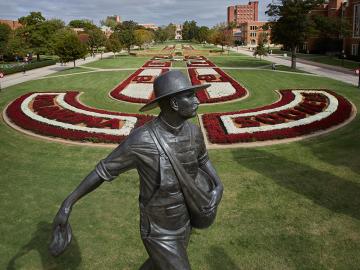
Filter News
Area of Research
- (-) Biology and Environment (37)
- (-) Materials for Computing (18)
- (-) National Security (7)
- Advanced Manufacturing (7)
- Building Technologies (1)
- Clean Energy (69)
- Computational Biology (1)
- Computational Engineering (2)
- Computer Science (4)
- Electricity and Smart Grid (1)
- Fusion and Fission (14)
- Fusion Energy (1)
- Isotopes (12)
- Materials (15)
- Mathematics (1)
- Neutron Science (16)
- Nuclear Science and Technology (1)
- Quantum information Science (3)
- Sensors and Controls (1)
- Supercomputing (21)
- Transportation Systems (1)
News Topics
- 3-D Printing/Advanced Manufacturing (4)
- Artificial Intelligence (2)
- Big Data (1)
- Bioenergy (10)
- Biology (18)
- Biomedical (4)
- Biotechnology (4)
- Chemical Sciences (5)
- Clean Water (5)
- Climate Change (5)
- Composites (2)
- Computer Science (8)
- Coronavirus (2)
- Cybersecurity (3)
- Decarbonization (1)
- Energy Storage (2)
- Environment (24)
- Exascale Computing (1)
- Fusion (1)
- High-Performance Computing (5)
- Isotopes (1)
- Materials (9)
- Materials Science (10)
- Mercury (3)
- Microscopy (4)
- Nanotechnology (5)
- National Security (5)
- Neutron Science (5)
- Polymers (5)
- Quantum Computing (1)
- Quantum Science (3)
- Security (2)
- Summit (2)
- Sustainable Energy (10)
- Transportation (2)
Media Contacts

Researchers at ORNL designed a novel polymer to bind and strengthen silica sand for binder jet additive manufacturing, a 3D-printing method used by industries for prototyping and part production.

A team led by the U.S. Department of Energy’s Oak Ridge National Laboratory demonstrated the viability of a “quantum entanglement witness” capable of proving the presence of entanglement between magnetic particles, or spins, in a quantum material.

Carrie Eckert applies her skills as a synthetic biologist at ORNL to turn microorganisms into tiny factories that produce a variety of valuable fuels, chemicals and materials for the growing bioeconomy.

ORNL and the University of Oklahoma, known as OU, recently executed a memorandum of understanding to officially recognize their partnership in pursuing shared research and development goals.

ORNL has named three researchers ORNL Corporate Fellows for their significant career accomplishments and continued leadership in their scientific fields.

Analytical chemists at ORNL have developed a rapid way to measure isotopic ratios of uranium and plutonium collected on environmental swipes, which could help International Atomic Energy Agency analysts detect the presence of undeclared nuclear

Oak Ridge National Laboratory researchers have created a technology that more realistically emulates user activities to improve cyber testbeds and ultimately prevent cyberattacks.

An ORNL team has successfully introduced a poplar gene into switchgrass, an important biofuel source, that allows switchgrass to interact with a beneficial fungus, ultimately boosting the grass’ growth and viability in changing environments.

For ORNL environmental scientist and lover of the outdoors John Field, work in ecosystem modeling is a profession with tangible impacts.

A team led by ORNL and the University of Michigan have discovered that certain bacteria can steal an essential compound from other microbes to break down methane and toxic methylmercury in the environment.


